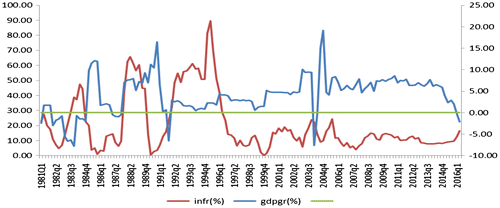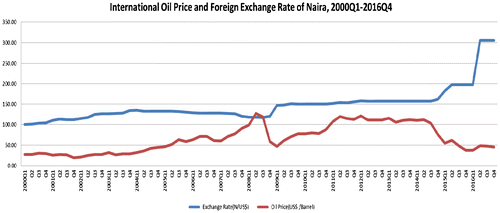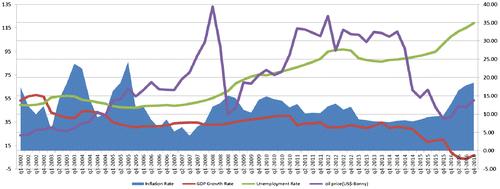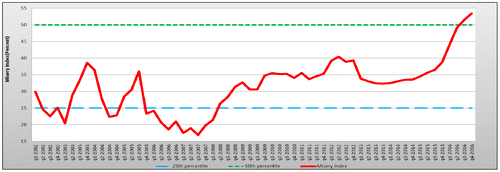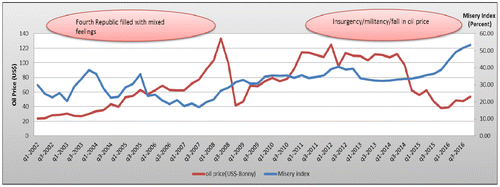 ?Mathematical formulae have been encoded as MathML and are displayed in this HTML version using MathJax in order to improve their display. Uncheck the box to turn MathJax off. This feature requires Javascript. Click on a formula to zoom.
?Mathematical formulae have been encoded as MathML and are displayed in this HTML version using MathJax in order to improve their display. Uncheck the box to turn MathJax off. This feature requires Javascript. Click on a formula to zoom.Abstract
This study adopts a dynamic approach to compute the level of economic distress in Nigeria. Quarterly series from 2002Q1 to 2016Q4 were utilized in computing the index. Leveraging on the expectations-augmented Phillips curve and Okun’s law, the results obtained indicate a minimum and maximum misery values of 16.92% (2007Q3) and 53.42% (2016Q4), respectively, with an average value of 31.49% over the study horizon. The index recorded a skewness of 0.31% indicating moderate level of asymmetry and a kurtosis of 3.26% indicating that the index is leptokurtically distributed with an approximate standard deviation of 8.00%. This implies the presence of appreciable level of volatility. A plot of crude oil price with the misery index overall shows that as price increased, the misery index decreased but in some instances, increase in crude oil price was consistent with increased misery. The persistent insecurity and militancy activities may have accounted for the observed puzzling co-movement. The computation also indicates that decrease in expected variation in inflation, results in increased unemployment by 61.0 per cent decrease in the variation in expected inflation associated with a unit change in the variation between the potential and actual rates of unemployment over the study horizon, which confirms theoretical expectations. On the whole, the results suggest that economic well-being in Nigeria has worsened over the years, especially between 2013Q3 and 2016Q4. The study, therefore, recommends sustained policies aimed at diversifying the revenue base of the economy away from heavy dependence on crude oil. This has the capacity to obviate the hardship occasioned by the fall in oil price and reduction in oil production.
Public Interest Statement
This paper tries to decompose the historical trend of poverty level between 2002Q1 and 2016Q4 as it relates to the level of unemployment, inflation and output. The study observed a trend between oil price shock and level of economic distress within the review period but however noticed a puzzle between the first two quarters in 2016. Against earlier established trend between oil price shock and economic distress, it was observed, that as oil prices were upticking, the level of misery continued to explode. This however may not be unconnected with the militancy in the Niger Delta which has led to a reduction in the production capacity and wastages emanating from the destruction of oil pipelines and export terminals vis–a–vis insurgency in the North-Eastern part of the country, considered to be the agricultural bed.
1. Introduction
Unemployment and inflation, the key components of the misery index, remain critical problems of macroeconomic management especially in developing countries. In Nigeria, inflation rates which remained moderated between 2006 and 2013 began to rise from 2014 to date. The records show that headline inflation rose from 8.0% in December 2014 to 18.6% in December 2016. Similarly, unemployment plus underemployment rate increased from 25.53% in December 2014 to 33.6% in 2016Q3.Footnote1 These negative developments have been exacerbated by the decline in GDP growth rates which turned negative within the first three quarters of 2016, suggesting that Nigeria is currently in stagflation; an economic condition characterized by declining growth, rising unemployment and rising inflation. This condition has implications for livelihood since inflation and growth are major factors that affect wages; hence, a critical assessment of the level of misery for Nigeria is germane.
The literature identifies the misery index (an unweighted sum of inflation and unemployment) as an important indicator of the economic well-being of citizens of an economy. The index, originally constructed by an economist, Arthur Okun in 1966, comprises inflation and unemployment rates for a particular economy. Over the years, other variants of the index have been developed such as the Barro’s misery index which includes interest rates and GDP into the mix. Barro (Citation1999)’s work has also been updated and applied to countries other than the United States. The index has since then become an important measure of economic livelihood in many countries (Cohen, Ferretti, & McIntosh, Citation2014; Nessen, Citation2008).
In Nigeria, no published empirical evidence of the computed misery index exists to the best of our knowledge. However, a combination of the level of inflation and unemployment has been broadly used as a mirror to gauge the level of misery in discussions and policy debates. This simplistic approach of gauging the misery index may exclude some important information that are relevant for effective policy-making in Nigeria and could be misleading. Cohen et al. (Citation2014) argue that a dynamic approach to computing the misery index based on output, unemployment and inflation, differs from the one proposed by Okuns since it contains more features and is able to distinguish between short-run and long-run phenomena. It is also adjudged to be a better signal of recession as opposed to expansion.
In line with National Bureau of Statistics (Citation2016), Nigeria entered into recession by the second quarter of 2016. As expected, periods of economic downturns are usually accompanied by worsening living standards for the citizenry. This development raises the following research questions. First, what is the level of economic distress in Nigeria? Second, given Nigeria’s heavy dependence on crude oil proceeds for revenue and economic management; what is the linkage between economic well-being and international oil price movements in Nigeria?
In response to the foregoing, computing the index is thus crucial in ascertaining the level of economic well-being occasioned by the economic recession. In addition, as important as the misery index is in guiding policy, the absence of a documented misery index in any refereed journal to the best of knowledge provides further justification for this study. This observed gap has prompted the current effort at not just computing the simple misery index but applying a dynamic approach and documenting it, as well as estimating the variation in expected inflation associated with a unit change in the potential and actual rates of unemployment was also computed.
In view of the foregoing, the main objective of the study is to compute a dynamic misery index for Nigeria. The aim is to provide policy-makers with a more robust index that measures the economic discomfort of Nigerians both on a short- and long-term basis. It will also serve as an early warning signal for economic recession to policy-makers and other economic agent. Given the importance of crude oil prices to the Nigerian economy, the index will be tracked against international crude oil price to ascertain the linkage between both variables. This is expected to strengthen the analysis.
To achieve the foregoing objectives, the paper is organized into five sections. Following the introduction, Section 2 examines stylized facts. Section 3 presents conceptual issues related to the misery index while model specification and estimation are contained in Section 4. Section 5 presents and discusses the results while Section 6 concludes the paper with some policy recommendations.
2. Stylized facts
2.1. Economic performance in Nigeria: A historical overview
In the 1960s, Nigeria was dependent on the agricultural export earning as a source of government revenue. With the discovery of petroleum oil in commercial quantity in the 1970s, the economy became heavily dependent on oil. Oil revenue, which was only 26.7% of the total collected revenue in 1970, rose astronomically to over 67% by 1978, after reaching a peak of 82.1% in 1974. About 92.9% of exports came from the oil sector in 1975 (Lambo, Citation1987).
However, while the oil boom provided the government the necessary revenue, it also gave rise to severe structural problems. The slowdown in agricultural production resulted in food shortages from the early 1970s. By 1974, the economy had become a net importer of basic foods. The huge foreign exchange earnings were used to import foods. There was also a “hot chase” for the benefit of the oil windfall from all segments of the society. Thus, there was a mass exodus of able-bodied men and women from the rural farmland to urban areas in search of white-collar jobs and a piece of the “oil cake”. This severely affected agricultural production (Lambo, Citation1987).
Though the growth rate of GDP during the oil boom was quite high, the boom encouraged increases in government spending which fuelled inflation. Statistics show that in 1975, the rate of inflation had risen to 33.96%, and stood at an annual average of 18% between 1976 and 1979. This high inflation rate persisted into the early part of the 1980s. Inflation rates for 1981 to 1985 were in double digits except for 1982. In Figure , growth rate of GDP was persistently negative during this period. Economic conditions during the period were particularly grave – the economy recorded over 10 quarters of negative economic growth and inflation rate reached 44.54% in the third quarter of 1984.
In the mid-1980s, when the structural adjustment policy (SAP) was introduced in 1986, the Nigerian economy witnessed some economic downturn. In 1987, the economy slumped into negative growth rates from the first quarter to the end of the year. The new exchange rate regime and other reforms led to substantial fluctuations in the exchange rate and the inflation rate hit 65.72% by the second quarter of 1988. Howbeit, there was slow economic recovery as growth rate of GDP ranged between 5.18 and 7.91% over the period 1988Q1 and 1990Q1.
Another short episode of negative economic conditions occurred in 2004, when negative economic growth rates were recorded within the first two quarters, −7.59 and −0.18%, of the year, respectively. Inflation rate for the same period stood at 22.46 and 14.10%. The sustained oil price increase during subsequent years ensured the stability of the foreign exchange rate and curbed inflationary pressure (Figure ).
The current episode of recession and negative economic conditions, commenced in 2014 with the collapse of crude oil prices. At the end of 2014, oil price fell to US$75.73 per barrel from US$112.30 per barrel as at end 2013. Exchange rate of the naira depreciated from N159.05/US$ as at end 2013 to N180.33/US$ at the end of 2014. By the end of 2015, oil price had fallen to US$43.84 per barrel while exchange rate of the naira stood at N196.99/US$. Economic performance decelerated but remained positive at 7.72, 5.94 and 2.11% for 2013Q4, 2014Q4 and 2015Q4, respectively. The deceleration in economic growth was accompanied by gradual acceleration in inflation rate from 7.96% as at 2013Q4 to 8.00 and 9.55% in 2014Q4 and 2015Q4, respectively. The economic recession became full blown in the first two quarters of 2016, when GDP growth rate turned negative, −0.36 and −2.06%, respectively. The inflation rate which hitherto had been single digit rose to 12.77 and 16.48% for 2016Q1 and 2016Q2, respectively.
2.2. Nigeria’s economic performance and well-being
The trajectory of growth, unemployment, inflation and oil price movements presented in the foregoing section has implications for the livelihood of Nigerians. One measure of wellness that is particularly relevant is the unemployment rate, since a key link through which economic growth is transmitted to improved livelihood is through employment generation. Thus, when unemployment remains persistent, there is an indication that economic well-being is deteriorating and vice versa. Figure contains the trend in quarterly GDP growth, unemployment and inflation rates and oil prices in Nigeria from 2002 to 2016. As the data shows, unemployment rates in Nigeria trended upwards and remained high and persistent even with high growth rates. For instance, when GDP growth rates averaged about 7.0% for almost a decade between 2004 and 2014, unemployment rates were also rising. This phenomenon has been termed “jobless growth”, indicating that Nigeria’s growth was not inclusive which has implications for livelihood and the misery index.
The persistent rise in unemployment rates even in periods when GDP growth rates were increasing remains disturbing.
The negative economic conditions in Nigeria in 2016, has been partly attributed to continued disruption of oil production, especially in the Niger Delta region and contraction in the non-oil sector. Available records from the National Bureau of Statistics indicate that in the second quarter of 2016, the oil sector contracted by 19.11%, Q on Q to average 1.69 million barrels per day, 0.42 million barrels lower than the 2.11 million bpd production recorded in the preceding quarter.
Similarly, the non-oil sector also contracted by 0.38% in real terms, which is lower than the growth of −0.18% reported in the first quarter of the year. This further underscores the relevance of the oil sector in the Nigerian economy.
The poor GDP growth recorded in Q2 (−2.06%), Q3 (−2.24%) and Q4 (−1.30%) in 2016 were also driven by worsened scarcity of the dollar which weakened the domestic currency. This further pushed up the prices of imported goods, especially raw materials, plants and machineries which fed into the production processes.
The negative economic conditions have raised concerns among policy-makers and all economic agents because of the implications for economic and social well-being.
3. Conceptual and literature review
The misery index otherwise known as the economic discomfort index (EDI) is one of the early attempts at developing a comprehensive index comprising a range of indicators for tracking macroeconomic conditions along the business cycles. The index, originally created by an economist, Arthur Okun in 1966, comprises inflation and unemployment rates for a specific economy. It was made popular in the early part of 1970s, when the United States of America was experiencing economic stagflation. As a result of the stagflation, a higher level of either inflation or unemployment was shown to have a negative impact on the welfare of the citizens. Okun, therefore, suggested the misery index as a measure of economic distress due to the significant cost burden imposed on the citizenry by the negative economic conditions in the United States at the time. In its original form, the index was computed as a combination of unemployment and inflation rates. As Mankiw (Citation2010) later explained, the index measures the level of economic discomfort as an unweighted sum of unemployment and inflation which constitutes two important indicators of macroeconomic policy outcomes.
Over the years, other variants of the index have been developed such as the Barro misery index which includes interest rates and GDP into the mix. Hufbauer, Kim, and Rosen (Citation2008) updated Barro (Citation1999) work and the index has been applied to other countries other than the United States, which was Barro’s focus. The index has since then, become an important measure of economic livelihood in many countries and employed by policy makers to guide policy (Cohen et al., Citation2014; Nessen, Citation2008).
It is interesting to note that the misery index has since found usefulness in many respect as in presaging election outcome (Susino, Citation2012) as well as providing some information about the presidential approval rating (Kleykamp, Citation2003). It has also been well-thought-out to be a reverse measure of economic good (Nessen, Citation2008).
Largely, the index is a vector quantity that has magnitude and direction that is usually triggered by the direction and magnitude of unemployment, growth rate and inflation at any given point in time. Hence, an upward movement in the misery index signals the presence of a negative consumer sentiment associated with an economic discomfort.
As earlier stated, there is no literature in any referred journal to the best of our knowledge containing a publish work on misery index in Nigeria. However, some pioneering efforts have been made in modelling and forecasting of unemployment by Tule, Ajilore, and Ebuh (Citation2016).
4. Theoretical framework
The misery index is derived by an addition of the current unemployment rate (µt) and the current absolute inflation rate (πt):(1)
(1)
where πt denotes the percentage change of the consumer price index, expressed in absolute value, because of problems associated with deflation (Lovell & Tien, Citation2000).
4.1. A modified approach to Okun’s law
Leveraging on Cohen et al. (Citation2014), a different application of the economic distress index (EDI) is the analysis of the “optimal levels of inflation and unemployment” (Golden, Orescovich, & Ostafin, Citation1990, Citation1987; Yang, Citation1992; Zaleski, Citation1990). This technique leveraging on the expectations-augmented Phillips curve and Okun’s law clearly distinguishes between the actual and natural rates of unemployment (Wiseman, Citation1992).
Cohen et al. (Citation2014) expressed the aggregate supply function as a relation between unanticipated inflation and cyclical unemployment, as:(2)
(2)
where πt represents actual inflation and expected inflation. In line with Bernanke, Olekalns, and Frank (Citation2008), α is a constant that measures the change in anticipated inflation (
) concomitant with a unit variation between actual (µt) and natural unemployment rates (µn).
Usually, when the rate of inflation is not fairly stable, its expected value can be substantially approximated by its potential (π*). Hence, the need for the expectations-augmented Phillips curves equation (Blanchard, Citation2011):(3)
(3)
Adding π* to both sides of Equation (3), results in the expression for the inflation rate at period t:(4)
(4)
If the parameter α is known, is used to replace πt in the original misery index.
In line with Okun (Citation1962) and Cohen et al. (Citation2014) introduced an algebraic relation between unemployment gap and output growth gap. Knotek (Citation2007) ascribed Okuns law to various marginally different equations that interlink the behaviour of unemployment and GDP during business cycle. The author utilized a gap version to relate (µt − µ*) to the variation between (gt) and (g*) as:(5)
(5)
where β in line with Blanchard (Citation2011) captures the rate at which deviations from the “normal” rate of growth are translated into changes in the unemployment rate. Hence, the addition of µ* to the left and right hand sides of Equation (5), gives:(6)
(6)
where µt is the potential unemployment rate minus some fraction (β) of the output gap. Equation (6) is therefore used to replace µt in Equation (1).
Therefore, by replacing the inflation and the unemployment rates in Equation (1) by their expressions in Equations (4) and (6), respectively, we have the modified approach as:(7)
(7)
4.2. Data description and measurement
The study employed quarterly data for actual headline inflation rate, potential headline inflation rate, potential unemployment rate, natural rate of unemployment, unemployment rate, actual gross domestic product growth rate and potential gross domestic output growth rate. The data covering the period from first quarter 2002 to fourth quarter 2016 were sourced primarily from the Central Bank of Nigeria and National Bureau of Statistics database. The choice of the period is intended to reflect historical and recent developments in the economy since the commencement of the fourth republic. The developments included periods of oil price boom, militancy in the Niger Delta, Insurgency in the North-East and the decline in oil prices leading to contraction in GDP and the subsequent period of recession as well as stagflation. All the variables used in the estimation process were expressed as rates, hence used in their original form without any transformation. The actual GDP growth rate, unemployment rate and headline inflation rate were used to generate potential output, unemployment and inflation, respectively, using Hodrick-Prescott technique. The description and measurement of these variables are contained in Table .
Table 1. Variables used and their descriptions
5. Results and discussion
The estimation begins with the computation of the unknown variables, followed by the parameters and before finally computing the quarterly misery index. The quarterly misery index is very important for policy formulation since it provides short-term signals of economic well-being alongside the gross domestic product (GDP) and the unemployment rate.
From Table , the potential unemployment rate (μ*) decreased from 13.17% in the 2002Q1 to 12.76% in 2005Q1 and increased to 12.78% in 2005Q2. From 2005Q2 to 2016Q4, it has been on an upward trend. It recorded a minimum value of 12.76 apiece in 2004Q4 and 2005Q1and a maximum value of 31.84% (2016Q4) with an average of 19.68% over the study horizon. It is asymmetric with a skewness of 0.36% and a kurtosis of 1.65% echoing the actual unemployment rate.
Table 2. Summary of results for unknown variables, parameters and the misery index
Similarly, the potential output (g*) recorded a minimum value of −0.39% (2016Q4) and a maximum value of 9.68% (2003Q2), and averaged 7.06% over the horizon. It is not normally distributed with a skewness of −1.44% and a kurtosis of 4.19%.
Also, the potential inflation rate (π*) recorded a minimum value of 10.10% (2013Q3) and a maximum value of 14.46% (2003Q2), with an average of 11.89% over the coverage horizon. It was found to be asymmetrically distributed with a skewness of 0.61% and a kurtosis of 1.90% indicating that, the actual inflation rate oscillates around its potential.
The computed α value of −0.61 indicates a 61.0% decrease in the variation in expected inflation associated with a unit change in the variation between the natural and actual rates of unemployment. This is the rate of a unit change in inflation that was sacrificed within the study horizon between the natural and the actual rate of unemployment.
However, the computed β value of 0.012 measures the variation between actual and potential unemployment to changes between actual and potential growth at 1.2%.
The misery index (Mt) as shown in Table is plotted in Figures and .
Generally, a higher index suggests worsened misery conditions for Nigerians while a lower index suggests improvements in economic conditions and livelihood. From Figure , the misery index in Nigeria was 12.94% in 2002Q1; it rose to 20.41% in 2003Q1 and further to 38.63% in 2003Q4. Overall, the misery index oscillates between 16.92 and 38.63% between 2002Q1 and 2008Q2 and generally on an upward trend till date reaching an all-time high rate of 53.42% in 2016Q4. This implies the misery index lies within 25–50% most of the times within the study horizon.
Similarly, a descriptive analysis of the quarterly misery index depicted in Figure shows that over the study period, it has a minimum of 16.92% (2007Q3) and a maximum of 53.42% (2016Q4), and averaged 31.49% over the study horizon. The index recorded a skewness of 0.31% indicating moderate level of asymmetry and a kurtosis of 3.26% indicating the presence of leptokurtic distribution with a standard deviation of 8.00% approximately. This implies the presence of appreciable level of volatility in the behaviour of the misery index.
As clearly itemized as one of the objectives of this study, because Nigeria is a country with a monoculture economy, there is need to plot the misery index with the oil price to ascertain whether there is a co-movement between the two as shown in Figure .
Overall, a striking observation from the graphic is the linkage between oil price movements and the misery index in Nigeria for most of the period. With the exception of 2014–2016, co-movements are observed in between international crude oil price and the misery index. An immediate explanation is the heavy reliance on crude oil proceeds as a major revenue source for the government. In fact, annual budgets in Nigeria have been benchmarked against crude oil price movements. It is, however, pertinent to note that most of the quarters between 2003Q1 and 2016Q4, a divergence was observed between the series, which deviates from the historical pattern. Over this period, increase in crude oil price was consistent with increased misery in Nigeria. This could be attributed to the Niger Delta unrest which impacted negatively on oil production, as well as, problems of insurgency in the north eastern part of Nigeria which affected livelihood. Other possible reasons could be huge cost of governance associated with democratic practice in Nigeria, huge population size and dearth of infrastructures. There is, however, the need for further research to better explore the dynamics of the misery index in the context of Nigeria’s business cycle.
6. Conclusion and policy recommendation
Leveraging on the modified approach to computing the misery index which involves the expectations-augmented Phillips curve and Okun’s law, a quarterly misery index for Nigeria was computed. From the results, the misery index in Nigeria has a minimum value of 16.92% (2007Q3) and a maximum value of 53.42% (2016Q4), and averaged 31.49% over the study horizon. The index recorded a skewness of 0.31% indicating moderate level of asymmetry and a kurtosis of 3.26% indicating the presence of leptokurtic distribution with a standard deviation of 8.00% approximately. This implies the presence of appreciable level of volatility in the behaviour of the misery index. The computed α = −0.61 indicates a 61.0% decrease in the variation in expected inflation associated with a unit change in the variation between the natural and actual rates of unemployment. A 1.2% increase in variation between actual and potential unemployment to changes between actual and potential growth was also reported over the study period. To this end, policies geared towards stimulating growth in employment intensive sectors are recommended as a means of improving economic well-being.
Overall, an upward trend with some measure of volatility was observed in the misery index in Nigeria, which indicates that economic well-being in Nigeria has worsened overtime. Finally, it was observed that as crude oil price increased, the misery index decreased but in some instances, a puzzling co-movement exist between the misery index and rising crude oil prices which could be partly attributed to Nigeria’s domestic challenges.
Hence, another key recommendation is the need for sustained policies aimed at diversifying the revenue base of the economy away from heavy dependence on crude oil. This has the capacity to obviate the hardship occasioned by the fall in oil price and reduction in oil production.
Funding
The authors received no direct funding for this research.
Disclaimer
This study should not be reported as representing the views of the CBN. The views expressed herein are those of the author(s) and are not necessarily those of the Central Bank of Nigeria and its Management.
Additional information
Notes on contributors
K. Moses Tule
K. Moses Tule is the lead author of this paper titled: A Dynamic Fragmentation of the Misery Index in Nigeria and the Director, Monetary Policy Department, Central Bank of Nigeria. He has special interest in researches that inform policy, especially monetary policy. He is a life member of The Nigerian Economic Society and a fellow of The Nigerian Statistical Association among others. He is well published in referred journals, both locally and internationally.
Notes
1. Nigeria’s National Bureau of Statistics (NBS) data base.
References
- Barro, R. J. (1999). Reagan vs. clinton: Who’s the economic champ? Business Week, 22, 5.
- Bernanke, B. S., Olekalns, N., & Frank, R. H. (2008). Principles of macroeconomics (2nd ed.). Australia: McGraw-Hill.
- Blanchard, O. (2011). Macroeconomics. New York, NY: Pearson.
- Cohen, I. K., Ferretti, F., & McIntosh, B. (2014). Decomposing the misery index: A dynamic approach. Cogent Economic and Finance, 2, 1–8.
- Golden, J. M., Orescovich, R., & Ostafin, D. (1987). Optimality on the short-run Phillips curve: A misery index criterion. A note. The American Economist, 31, 72.10.1177/056943458703100212
- Golden, J. M., Orescovich, R., & Ostafin, D. (1990). Optimality on the short-run Phillips curve: A misery index criterion. A reply. The American Economist, 34, 92.10.1177/056943459003400217
- Hufbauer, G., Kim, J., & Rosen, H. (2008). The augmented misery index (A Working Paper). Washington, DC: Peterson Institute for International Economics.
- Kleykamp, D. L. (2003). The economy and presidential approval ( A working Paper series). Taipei: Tamkang University.
- Knotek, E. S. (2007). How useful is the Okun’s law? Economic Review of the Federal Reserve Bank of Kansas City, 4, 73–103.
- Lambo, T. (1987) Nigerian economy: A textbook of applied economics Evans brothers. Ibadan: (Nigeria Publishers) Limited.
- Lovell, M. C., & Tien, P. L. (2000). Economic discomfort and consumer sentiment. Eastern Economic Journal, 26, 1–8.
- Mankiw, N. G. (2010). Macroeconomics. New York, NY: Worth.
- National Bureau of Statistics. (2016). Statistical data for unemployment, inflation and GDP growth rates.
- Nessen, R. (2008). Arthur Okun father of the misery index. Washington, DC: Opinion–The Brookings Institution.
- Okun, A. M. (1962). Potential GNP: Its measurement and significance. Proceedings of the Business and Economics Statistics Section (pp. 98–104). Washington, DC: American Statistical Association.
- Susino, M. L. (2012). The misery index and the U.S. presidential election ( Working Paper). Miami, FL: Department of Economics, University of Miami.
- Tule, M. K., Ajilore, T. O., & Ebuh, G. U. (2016). A composite index of leading indicators of unemployment in Nigeria. Journal of African Business, 17, 87–105.10.1080/15228916.2016.1113909
- Wiseman, C. (1992). More on misery: How consistent are alternative indices? A comment. The American Economist, 36, 85–88.10.1177/056943459203600212
- Yang, B. (1992). Optimality on the short-run Phillips curve revisited. The American Economist, 36, 89–91.10.1177/056943459203600213
- Zaleski, P. A. (1990). On the optimal level of macroeconomic misery: A comment. The American Economist, 34, 90–91.10.1177/056943459003400216

